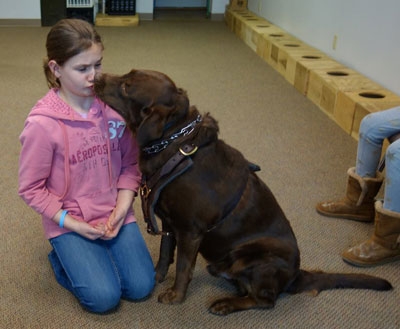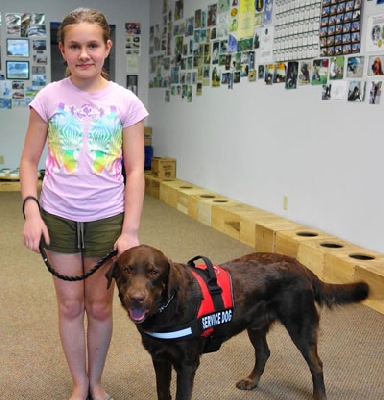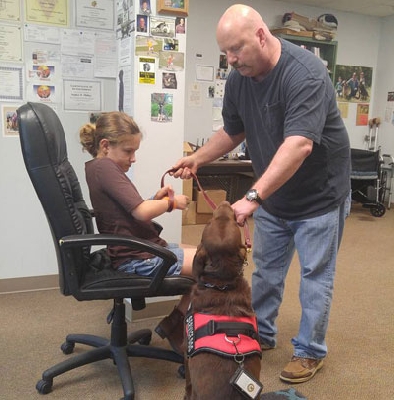 The term Seizure Alert Dog covers a variety of activities associated with a Service Dog's response to a seizure. Some dogs have been trained to bark, jump, push closely against the Handler, lick, or otherwise alert families when a child has a seizure while playing outside or is sleeping in another room. Some dogs learn to lie next to someone having a seizure to prevent injury. Others are said to be able to activate alarm systems, or alert the Handler prior to the full onset of the seizure and stay with the Handler until the seizure subsides of fades away. Service Dogs that are trained to respond in various ways when someone has a seizure are no different from service dogs for other disabilities. Public interest in seizure assistance dogs has fueled demand for dogs with these skills. Some Handlers with seizures have found that the trained Seizure Alert Dogs help them with obtaining speedy assistance when a seizure occurs, or is about to occur, or the Service Dog is alerting others for help. Dogs can be trained as Service Dogs for people with seizures and the Americans with Disabilities Act protects a Handler's right to use the Service Dog in any place of public accommodation.
The term Seizure Alert Dog covers a variety of activities associated with a Service Dog's response to a seizure. Some dogs have been trained to bark, jump, push closely against the Handler, lick, or otherwise alert families when a child has a seizure while playing outside or is sleeping in another room. Some dogs learn to lie next to someone having a seizure to prevent injury. Others are said to be able to activate alarm systems, or alert the Handler prior to the full onset of the seizure and stay with the Handler until the seizure subsides of fades away. Service Dogs that are trained to respond in various ways when someone has a seizure are no different from service dogs for other disabilities. Public interest in seizure assistance dogs has fueled demand for dogs with these skills. Some Handlers with seizures have found that the trained Seizure Alert Dogs help them with obtaining speedy assistance when a seizure occurs, or is about to occur, or the Service Dog is alerting others for help. Dogs can be trained as Service Dogs for people with seizures and the Americans with Disabilities Act protects a Handler's right to use the Service Dog in any place of public accommodation.
Many people believe Seizure Alert Dogs (dogs that sense and warn their masters of upcoming seizures and provide assistance to their Handlers before, during, and after a seizure) can provide The Handlers with a greater sense of control over their seizures because they seem to be able to help them avoid catastrophes in public places, such as being out in public and while at home sleeping. While many medical professionals do not doubt that there are dogs with the ability to predict seizures, they are wary of relying on them 100 percent. After all, dogs are not perfect, much like their Handler. The Seizure Alert Dog is trained to detect and go to Trained Final Response to the changes in available Body Odor of the Handler brought on by the body going into a Distressed Body Odor mode because of chemical changes brought on by the seizure.
 Owners of Seizure Alert Dogs report that their Service Dogs typically begin warning them of impending seizures anywhere from 30 seconds to 45 minutes prior to an episode. Each dog is trained to do its own type of alerting, which could include pawing, climbing on, licking, barking, circling and making close eye contact with the Handler. Usually, the Service Dog alert spurs the Handler to stay quiet in a safe place until the seizure passes or has taken its course. Seizure Alert Dogs are even trained to lie down next to, or on top of, the Handler during a seizure, providing the Handler comfort and preventing unintentional injury. The Trainer and the Handler together will figure out what type of Alert is needed. The Trainer will then train the dog to perform the Trained Final Response at the proper time, just like a Drug Dog or a Bomb Dog or any other type of Detection Dog. The Seizure Alert Dog is not only a Detection Dog, but also a Service Dog as described in the Americans with Disability Act.
Owners of Seizure Alert Dogs report that their Service Dogs typically begin warning them of impending seizures anywhere from 30 seconds to 45 minutes prior to an episode. Each dog is trained to do its own type of alerting, which could include pawing, climbing on, licking, barking, circling and making close eye contact with the Handler. Usually, the Service Dog alert spurs the Handler to stay quiet in a safe place until the seizure passes or has taken its course. Seizure Alert Dogs are even trained to lie down next to, or on top of, the Handler during a seizure, providing the Handler comfort and preventing unintentional injury. The Trainer and the Handler together will figure out what type of Alert is needed. The Trainer will then train the dog to perform the Trained Final Response at the proper time, just like a Drug Dog or a Bomb Dog or any other type of Detection Dog. The Seizure Alert Dog is not only a Detection Dog, but also a Service Dog as described in the Americans with Disability Act.
Seizure sufferers who are fortunate enough to be a Handler of a Seizure Detection Dog (which insurance normally will not cover) are carefully screened to ensure that they can provide the canine with the appropriate care and attention after Training. Handlers must also be willing and able to make the financial commitment, including initial cost of the dog, the Training of the dog, Veterinary costs, equipment costs and other miscellaneous costs. In addition, the Service Dogs need continuous training to keep their skills sharp.
Once a Handler has a Seizure Alert Dog, medical professionals caution Handlers and their families to remember that even though their dogs are amazing, they're still fallible. No dog trained in any capacity is 100 percent. This Service Dog is a tool to help the Handler with the most normal life as possible.
The Department of Justice (DOJ) issued updated regulations on service animals, which became effective on March 15, 2011. Under the ADA, a "service animal" is any dog that is individually trained to do work or perform tasks for the benefit of an individual with a disability, including physical, sensory, psychiatric, intellectual or other mental disability. Only a dog can qualify as a "service animal," however the ADA also requires that reasonable accommodations be made to permit the use of a miniature horse by an individual with a disability so long as it has been "individually trained to do work or perform tasks for the benefit of the individual with a disability."28 C.F.R. - 36.101.
The work or tasks performed by a service animal must directly relate to the handler's disability (for example, assisting individuals who are blind or have low vision with navigation or other tasks). However, the provision of emotional support, well-being, comfort or companionship is not the type of "work or tasks" considered in the ADA's definition of service animal. Those having a dog for companionship will not be considered a service animal.
 According to DOJ regulations, an entity (such as businesses and schools) cannot require documentation that the animal is a service animal. Instead, entities may ask two questions: 1) whether an animal is required because of a disability, and 2) what task or work the animal has been trained to perform. They cannot otherwise ask about the nature or extent of an individual's disability, nor can they ask these questions when it is "readily apparent that an animal is trained to do work or tasks for an individual with a disability." 28 C.F.R. | 36.101. However, courts have refused to find an ADA violation where the individual with the alleged service animal refuses to respond to legitimate inquiries.
According to DOJ regulations, an entity (such as businesses and schools) cannot require documentation that the animal is a service animal. Instead, entities may ask two questions: 1) whether an animal is required because of a disability, and 2) what task or work the animal has been trained to perform. They cannot otherwise ask about the nature or extent of an individual's disability, nor can they ask these questions when it is "readily apparent that an animal is trained to do work or tasks for an individual with a disability." 28 C.F.R. | 36.101. However, courts have refused to find an ADA violation where the individual with the alleged service animal refuses to respond to legitimate inquiries.
Entities must modify policies and practices to permit the use of a service animal by an individual with a disability in any area open to the general public unless the entity can demonstrate: 1) the modification would fundamentally alter the nature of the entity's goods, services, facilities, privileges, advantages or accommodations, 2) the safe operation of the entity would be jeopardized, or 3) such modification would result in an undue financial or administrative burden.
If an entity does not allow an individual with a disability to be accompanied by their service animals in an area open to the general public, an individual can seek injunctive relief such as adjusting a policy or providing an auxiliary aid or service under Title II or III of the ADA or under Section 504 of the Rehabilitation Act. Individuals have also brought complaints to the DOJ and through this course have had success in obtaining monetary relief. In certain situations, a claim may also be brought under the Fair Housing Act, the Rehabilitation Act of 1973, the Air Carrier Access Act, as well as state civil and criminal statutes and local anti-discrimination ordinances.
